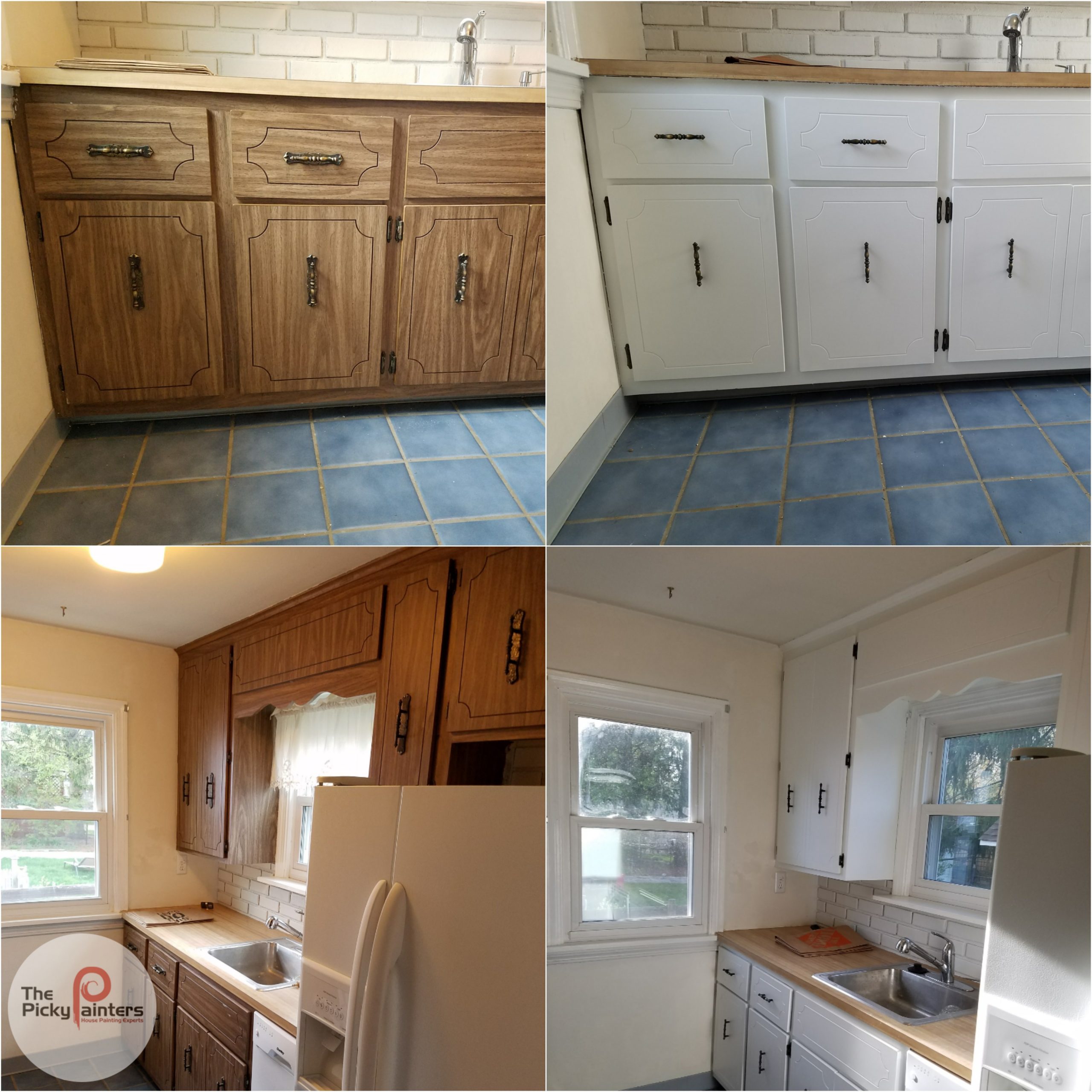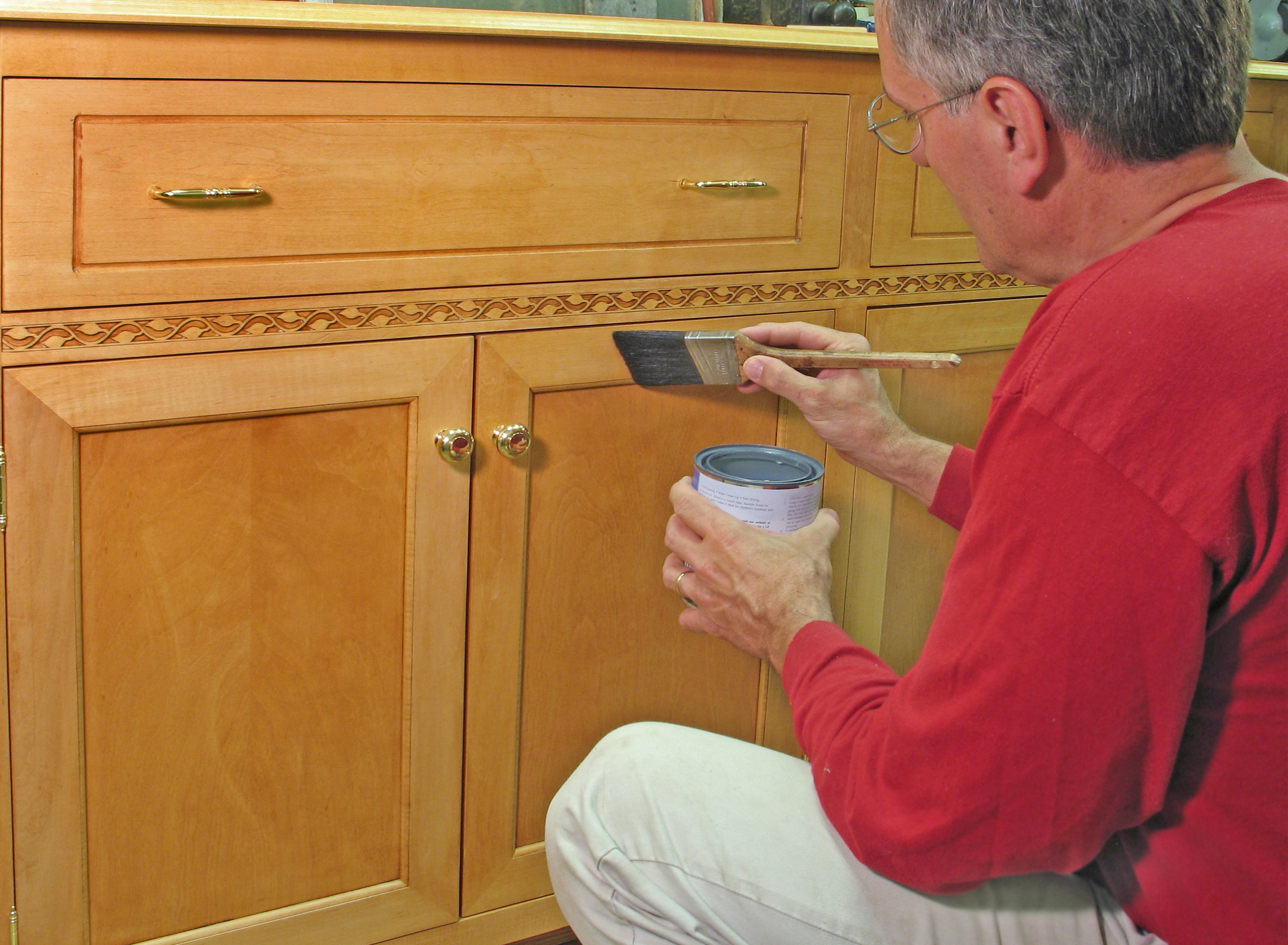Preparing Cabinets for Spray Painting

Proper preparation is crucial for a professional-looking, long-lasting spray paint finish on your cabinets. Skipping steps can lead to peeling, chipping, and an uneven appearance. This section details the essential steps to ensure your cabinets are ready for a perfect paint job.
Surface Preparation Methods
Choosing the right surface preparation method depends on the condition of your cabinets and the desired finish. The following table compares several techniques:
| Method | Description | Pros | Cons |
|---|---|---|---|
| Light Sanding | Using fine-grit sandpaper (220-grit or higher) to smooth out minor imperfections. | Quick, easy, suitable for cabinets in good condition. | May not address significant damage. |
| Medium Sanding | Using medium-grit sandpaper (120-150 grit) to remove more significant imperfections like scratches or minor damage. | Addresses more substantial imperfections than light sanding. | Requires more effort and time. |
| Heavy Sanding | Using coarser sandpaper (80-100 grit) to remove significant damage, old paint, or varnish. | Prepares severely damaged surfaces for repainting. | Can be time-consuming and may require significant effort. |
| Chemical Stripping | Using a chemical stripper to remove old paint or varnish. | Effective for removing multiple layers of paint. | Can be messy, requires proper ventilation and safety precautions. |
Removing Hardware and Protecting Surroundings
Thoroughly removing all cabinet hardware prevents paint buildup and ensures an even finish. Protecting surrounding areas prevents overspray and simplifies cleanup. Here’s a step-by-step guide:
- Remove all cabinet doors and drawers.
- Remove all hardware (knobs, handles, hinges) using a screwdriver or other appropriate tools. Label each piece and store them safely to avoid mix-ups during reinstallation.
- Clean the cabinet surfaces thoroughly with a degreaser to remove any grease, dirt, or grime.
- Mask off surrounding areas, such as walls, countertops, and floors, using painter’s tape and drop cloths. Pay close attention to areas adjacent to the cabinets.
- Consider using plastic sheeting to create a more comprehensive barrier against overspray.
Primer Selection and Application
The type of primer used depends heavily on the cabinet material. Selecting the correct primer ensures proper adhesion and prevents issues like paint bleeding or discoloration.
- Wood Cabinets: A high-quality oil-based or shellac-based primer is often recommended for wood cabinets, offering excellent adhesion and sealing properties. Oil-based primers provide a smoother surface for the final coat of paint. Apply with a brush, roller, or spray gun, ensuring even coverage.
- Laminate Cabinets: A bonding primer is essential for laminate surfaces as it provides better adhesion than standard primers. This is because laminate is a non-porous material. Apply with a brush, roller, or spray gun, allowing for sufficient drying time between coats.
- MDF (Medium-Density Fiberboard) Cabinets: MDF absorbs moisture readily. A stain-blocking primer is recommended to prevent bleed-through from the MDF substrate. Apply with a brush, roller, or spray gun, ensuring even coverage.
Choosing and Applying Spray Paint: Can You Spray Paint Cabinets

Choosing the right spray paint and applying it correctly are crucial for achieving a professional-looking finish on your kitchen cabinets. The type of paint you select will significantly impact the durability, final appearance, and the overall time investment in your project. Proper application techniques minimize imperfections and ensure a smooth, even coat.
Spray Paint Types for Cabinets
The choice of spray paint depends on your desired finish and the level of durability needed. Different types offer varying advantages and disadvantages. The following table compares three common types suitable for cabinet refinishing.
| Spray Paint Type | Durability | Finish | Drying Time |
|---|---|---|---|
| Acrylic Lacquer | High; resists scratches and chipping. Excellent for high-traffic areas. | Smooth, hard, and glossy; can be easily sanded and re-coated. | Relatively fast; usually dry to the touch within 30 minutes, allowing for quicker recoating. |
| Acrylic Enamel | Moderate; durable enough for most kitchen cabinets but may show wear over time with heavy use. | Smooth, durable; available in various sheens, from matte to high-gloss. | Moderate; typically takes 1-2 hours to dry to the touch, with longer drying times between coats. |
| Oil-Based Enamel | High; very durable and resistant to scratches and chemicals. | Hard, glossy finish; tends to yellow slightly over time. | Slowest drying time; can take several hours to dry to the touch, and requires significantly longer drying times between coats (often 24 hours or more). |
Proper Spray Painting Technique
Achieving a smooth, even finish requires a methodical approach to spray painting. The following steps Artikel the proper technique.
Can you spray paint cabinets – Careful application is key to avoiding runs, drips, and an uneven finish. Consistency is paramount.
- Maintain a Consistent Distance: Hold the spray can approximately 6-8 inches from the cabinet surface. Maintaining a consistent distance prevents uneven application and heavy buildup in certain areas.
- Use Smooth, Even Passes: Move the spray can smoothly and at a constant speed, overlapping each pass by approximately 50%. Avoid pausing in one spot.
- Apply Thin Coats: Multiple thin coats are preferable to one thick coat. Thick coats are more prone to runs and drips and take much longer to dry.
- Use a Light Touch: Don’t press the spray nozzle too hard; a light, even pressure is all that is needed.
- Allow Adequate Drying Time: Allow each coat to dry completely before applying the next coat, following the manufacturer’s drying time recommendations.
- Practice on Scrap Wood: Before spraying your cabinets, practice your technique on a piece of scrap wood to get a feel for the spray pattern and to adjust your technique.
Visual Representation of Spray Pattern and Overlapping
Imagine a rectangular area representing the cabinet door. The spray pattern from the can should be visualized as a slightly wider rectangle, creating a slightly wider spray than the actual cabinet area. The first pass covers the left half of the area, with the can moving smoothly and consistently from left to right. The second pass overlaps the first by approximately 50%, starting from the middle and moving right to cover the right half of the area. The overlapping ensures even coverage and prevents visible streaks or gaps. This pattern is repeated for each coat, ensuring complete coverage and a smooth, professional finish. The edges of the spray pattern should be feathered out lightly to avoid heavy buildup at the edges.
Finishing and Maintenance

Achieving a professional-looking finish on your spray-painted cabinets requires attention to detail throughout the process, from preparation to the final coat. Proper maintenance will then ensure your cabinets remain beautiful for years to come. This section covers techniques for achieving a smooth finish, necessary safety precautions, and a long-term maintenance plan.
Achieving a smooth, even finish on your spray-painted cabinets involves careful application of multiple coats and addressing any imperfections that may arise. This process requires patience and attention to detail, but the results are well worth the effort.
Techniques for Achieving a Smooth Finish
Several techniques contribute to a flawless finish. These methods address common issues and ensure a professional look.
- Light sanding between coats: Lightly sanding with fine-grit sandpaper (220-320 grit) between coats helps smooth out any imperfections and creates a better surface for the next coat to adhere to. This removes any dust nibs or minor inconsistencies.
- Thin coats are key: Applying multiple thin coats, rather than one or two thick coats, prevents runs and drips, leading to a more even and smooth finish. Allow each coat to dry completely before applying the next.
- Tack cloth removal: Use a tack cloth to remove dust and debris before each coat. This ensures that the new coat adheres properly and prevents imperfections from being trapped beneath the surface.
- Wet sanding for final coat: For an ultra-smooth finish, wet sanding with very fine grit sandpaper (400 grit or higher) can be done after the final coat has fully cured. This removes any minor imperfections and leaves a glass-like surface.
- Proper drying time: Allow adequate drying time between coats according to the paint manufacturer’s instructions. Rushing the process can lead to problems with adhesion and an uneven finish.
Ventilation and Safety Precautions, Can you spray paint cabinets
Spray painting involves the use of potentially harmful chemicals, so proper ventilation and safety measures are crucial to protect your health and the environment.
- Well-ventilated area: Always work in a well-ventilated area, preferably outdoors or in a space with excellent ventilation, such as a garage with the door open. Consider using a respirator mask to further reduce inhalation of paint fumes.
- Protective gear: Wear appropriate personal protective equipment (PPE), including a respirator mask, safety glasses, and gloves. This will protect your skin and respiratory system from harmful chemicals.
- Fire safety: Spray paint is flammable. Keep away from open flames and sparks. Ensure that the area is well-ventilated to avoid the build-up of flammable fumes.
- Disposal of materials: Dispose of used spray cans and other materials properly according to local regulations. Never puncture or incinerate spray cans.
Cabinet Maintenance Guide
Maintaining your newly painted cabinets will extend their lifespan and keep them looking their best. Regular cleaning and occasional touch-ups are key.
| Cleaning Product | Cleaning Method | Frequency | Notes |
|---|---|---|---|
| Mild dish soap and water | Wipe down with a soft, damp cloth | Weekly | Avoid harsh scrubbing. |
| All-purpose cleaner (diluted) | Spray on, wipe clean with a soft cloth | Monthly | Test in an inconspicuous area first. |
| Baking soda paste | Apply paste to stubborn stains, gently scrub, wipe clean | As needed | Effective for grease and grime. |
| Touch-up paint | Apply a small amount of paint to any chips or scratches, allow to dry completely. | As needed | Use the same paint as the original application. |
